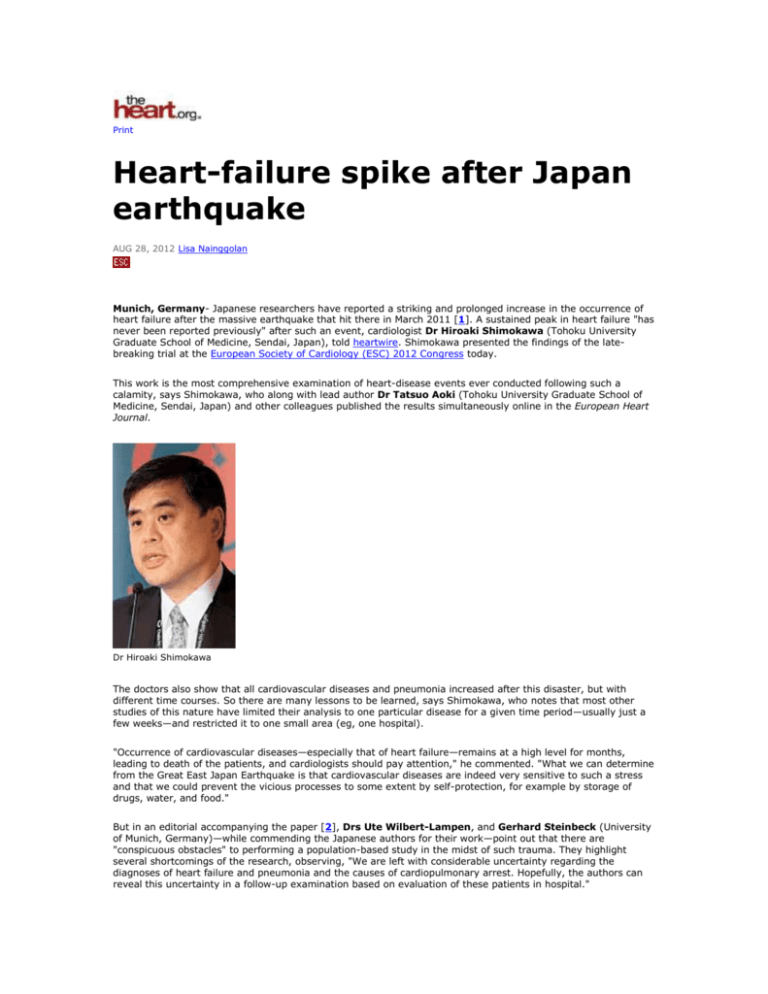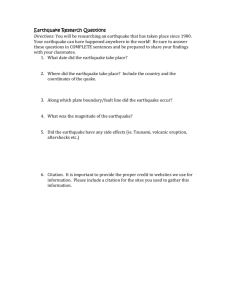
Print
Heart-failure spike after Japan
earthquake
AUG 28, 2012 Lisa Nainggolan
Munich, Germany- Japanese researchers have reported a striking and prolonged increase in the occurrence of
heart failure after the massive earthquake that hit there in March 2011 [1]. A sustained peak in heart failure "has
never been reported previously" after such an event, cardiologist Dr Hiroaki Shimokawa (Tohoku University
Graduate School of Medicine, Sendai, Japan), told heartwire. Shimokawa presented the findings of the latebreaking trial at the European Society of Cardiology (ESC) 2012 Congress today.
This work is the most comprehensive examination of heart-disease events ever conducted following such a
calamity, says Shimokawa, who along with lead author Dr Tatsuo Aoki (Tohoku University Graduate School of
Medicine, Sendai, Japan) and other colleagues published the results simultaneously online in the European Heart
Journal.
Dr Hiroaki Shimokawa
The doctors also show that all cardiovascular diseases and pneumonia increased after this disaster, but with
different time courses. So there are many lessons to be learned, says Shimokawa, who notes that most other
studies of this nature have limited their analysis to one particular disease for a given time period—usually just a
few weeks—and restricted it to one small area (eg, one hospital).
"Occurrence of cardiovascular diseases—especially that of heart failure—remains at a high level for months,
leading to death of the patients, and cardiologists should pay attention," he commented. "What we can determine
from the Great East Japan Earthquake is that cardiovascular diseases are indeed very sensitive to such a stress
and that we could prevent the vicious processes to some extent by self-protection, for example by storage of
drugs, water, and food."
But in an editorial accompanying the paper [2], Drs Ute Wilbert-Lampen, and Gerhard Steinbeck (University
of Munich, Germany)—while commending the Japanese authors for their work—point out that there are
"conspicuous obstacles" to performing a population-based study in the midst of such trauma. They highlight
several shortcomings of the research, observing, "We are left with considerable uncertainty regarding the
diagnoses of heart failure and pneumonia and the causes of cardiopulmonary arrest. Hopefully, the authors can
reveal this uncertainty in a follow-up examination based on evaluation of these patients in hospital."
Increases in CVD following earthquake independent of age, sex
One of the largest ocean-trench earthquakes ever recorded in Japan, with a magnitude of 9.0 on the Richter
scale, hit the northeast coast there on March 11, 2011. The earthquake and resulting tsunami caused massive
damage, leaving more than 15 000 people dead and over 3000 missing, with almost 400 000 homes destroyed.
Shimokawa and his team examined all ambulance-transport records in the Miyagi prefecture (home to 2.3 million
people), close to the epicenter of the earthquake, from February 11 to June 30 for each year from 2008 to 2011
(ie, four weeks before to 16 weeks after March 11, a total of 124 152 records). Incidence records from before,
during, and after the earthquake disaster were compared, with aftershocks counted and recorded according to a
seismic intensity of 1.0 or greater.
They found that the weekly occurrence of five conditions—heart failure, acute coronary syndrome (including
unstable angina and acute MI), stroke, cardiopulmonary arrest (CPA), and pneumonia—all increased sharply soon
after the earthquake occurred, compared with the previous three years.
The occurrences of ACS and CPA showed a rapid increase followed by a sharp decline, whereas those of HF and
pneumonia showed a prolonged increase for more than six weeks and those of stroke and CPA showed a second
peak after the largest aftershock (April 7, 2011). These increases were independent of age, sex, or residence
area (seacoast vs inland).
"To the best of our knowledge, this is the first report that demonstrates the mid-term courses of the occurrences
of major CVDs and pneumonia after a great earthquake" in a large-scale population, the authors state.
Study shortcomings include speculation on causal mechanisms
Lampen and Steinbeck point out, however, that the diagnoses of heart failure and pneumonia given by doctors in
the emergency room were not defined. Also, symptoms are not reported for heart failure, and it is not known
which findings documented the presence of structural heart disease.
In addition, there are no data to differentiate between cardiac and pulmonary causes of arrest. "This is
unfortunate in view of the fact that the tsunami caused an increase of pneumonia and was responsible for most
of the deaths, and many cases of cardiopulmonary arrest might have been due to aspiration, cooling, drowning,
etc," they observe. And no information is available about disease history and drug treatment of the affected
patients, they point out.
Finally, they wonder, what could be the mechanism of the prolonged increase in cardiovascular disease,
especially of heart failure by four weeks, diagnosed when patients were attended by emergency ambulances?
"Explanations given by the authors are purely speculative," they state. "Either the stressor had persisted for
weeks, for example because of frequent aftershocks, or the increase of cardiovascular disease, and especially
heart failure, is caused, more likely in our opinion, in a complex way by the consequences of the humanitarian
catastrophe: the trauma, breakdown of lifelines—water, food, electricity, traffic, the emergency system—
evacuation, and freezing temperature, plus aspiration pneumonia and drowning due to the tsunami.
"Whatever the mechanism, however, the study . . . clearly points out that a catastrophe such as this is a
challenge to any healthcare system forced to deal with increased cardiovascular disease not only for days, but for
weeks and months," they conclude.
Timeline important to identify different stressors
Shimokawa says one very important take-home message from the study relates to "the time course of different
stresses over months."
In the acute phase, he says, it's the shortage of drugs, water, and electricity that are key. In the subacute phase,
increased salt intake seems to play an important role, and in the chronic phase, mental and physical stresses due
to people being housed in shelters or temporary homes are likely factors.
Authors and editorialists report no conflicts of interest.
Sources
1.
2.
Aoki T, Fukumoto T, Yasuda S, et al. The Great East Japan Earthquake Disaster and cardiovascular diseases.
Eur Heart J 2012; DOI:10.1093/eurheartj/ehs288. Available at: http://eurheartj.oxfordjournals.org.
Earthquakes: Another cause of heart failure? Wilbert-Lampen U and Steinbeck G. Eur Heart J 2012;
DOI:10.1093/eurheartj/ehs297. Available at: http://eurheartj.oxfordjournals.org.
Related links
Real-time ECG telemonitoring shows massive rise in lesions during Chile 2010 earthquake
[Acute Coronary Syndromes > Acute coronary syndromes; Sep 02, 2011]
Tripling of heart attack risk persisted four years after Katrina
[Acute Coronary Syndromes > Acute coronary syndromes; Apr 03, 2011]
The crashing stock market and AMI
[Acute Coronary Syndromes > Acute coronary syndromes; Nov 30, 2010]
Life after Katrina: A long way from normal in New Orleans
[heartwire > News; Mar 27, 2007]
Healthcare lessons to be learned from Katrina
[heartwire > News; Mar 14, 2006]
Dramatic rise in stress-induced cardiomyopathy cases after strong earthquakes hit Japan
[heartwire > News; Jul 21, 2005]
Striking at the heart of America: Trauma of 9/11 linked to spike in MI
[heartwire > News; Jan 13, 2005]
The rattled hearts of September 11th: ICDs likely prevented deaths
[HeartWire > News; May 10, 2002]
Copyright ®1999-2012 theheart.org by WebMD. All rights reserved.
Privacy policy
info@theheart.org







